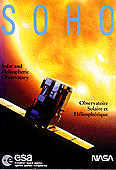|
Stellar Temperature Measurement
This question started it all: Thank you - Mr.
Sunspot!! - Dr Louis Strous - NSO/Sacramento Peak
The answer: Temperature Astronomers measure the temperature of far-away things (Stars) by investigating the radiation (mostly light) that they emit, and they can do that right here from the Earth. Astronomers use the same effects that you see if you heat up a piece of iron. You don't feel any radiation (heat) coming from a cold piece of iron, but it's still emitting a little radiation. If you heat up the iron you will start feeling its heat even when you are not touching it. This heat that you feel is the infrared radiation that the iron emits because of its temperature. The hotter you make the iron, the more heat you'll feel. If you make the iron hot enough, it also starts to glow: first a dull red (red-hot), and finally a bright white (white-hot). So, if you heat up a piece of iron you notice three effects: when the iron gets hotter, you feel more heat coming from it, it glows brighter, and its color changes. These things don't just happen with pieces of iron, but with any material, including the material in the Sun. Heat is not the only thing that can make stuff glow, though. Some things can glow even when they are cold, for instance a fluorescent light, and a television or computer screen (which also uses a kind of fluorescence). These are called continuum sources because they emit light at every wavelength in a broad range, not just at a few specific wavelengths. If scientists can measure the total light output, including the infrared heat, they can find the object's temperature. So, you can measure something's temperature by measuring how much energy (heat and light) it emits, and by checking the color(s) of the light that it emits. To find the temperature of the object from its light, it is important that you look at only the light that the object itself emits, and not at light from some other source that it reflects. The colors you see around you during the day are caused by reflected sunlight, so they do not say anything about the temperature of things on Earth, but rather about the temperature of the visible surface (the photosphere) of the Sun. Scientists long ago figured out what temperature goes with what color and what brightness, so if they know the brightness or color, then they can easily determine the temperature. If you don't know how far away the thing is that you're looking at, then you can only use the color to figure out what temperature it has. This is the case for many stars. In this way, the surface temperature of the Sun has been found to be about 5770 kelvin, or 9900 degrees F, or 5500 degrees C.
As you surf each web site listed below, look for as much information as you can about solar temperature. At the end of this section, you will be given an opportunity to check your learning. Windows to the Universe. Windows to the Universe is a user-friendly learning system on the Earth and Space sciences for the use of the general public. Funded by NASA, is to develop an innovative and engaging Web-site that spans the Earth and Space sciences. These notes were created by Nick Strobel for the introductory astronomy courses that he teaches. They are offered to the net as a resource in astronomy education. This set of notes covers: The properties of stars, types of Stars and HR diagram. |















